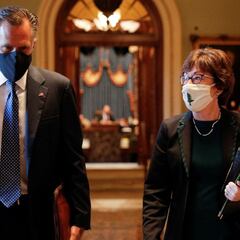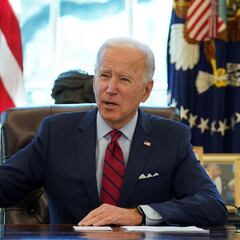Third stimulus check: how targeted were first two covid-19 payments?
A group of Republican senators has proposed a third stimulus check of up to $1,000 that would come with more limited eligibility requirements than the first two direct payments.

United States President Joe Biden is on Monday due to hold talks with a group of 10 Republican senators over their $600bn coronavirus relief proposal - a plan that includes a stimulus check of up to $1,000.
The offer tabled by the GOP senators is less than a third the size of Biden’s $1.9tn American Rescue Plan (ARP), and significantly reduces the maximum stimulus check eligible Americans would receive. In the president’s economic-aid proposal, the third round of checks would see people get up to $1,400.
GOP senators' plan reduces ARP stimulus check by $400
Furthermore, eligibility for the full $1,000 would be more limited than in the first two rounds of stimulus checks, with only those earning under $50,000 a year qualifying for the maximum payment.
The formula for calculating how many higher earners would qualify for a partial check would also be changed, so that fewer people over the basic income threshold would receive any kind of payment.
In a letter sent to Biden on Sunday, the Republican senators - Susan Collins, Lisa Murkowski, Bill Cassidy, Mitt Romney, Rob Portman, Shelley Moore Capito, Todd Young, Jerry Moran, Michael Rounds and Thom Tillis - said the proposal would also include an extra credit for "dependent children and adults".
Limit third stimulus check to "families who need assistance the most", says group of GOP senators
The reduced third-stimulus-check proposal comes amid calls from Republican congressmen and women and some more moderate Democratic lawmakers to bring down the overall cost of such a program.
In their letter to Biden, the group of 10 GOP senators stressed that they supported sending a stimulus check only to "those families who need assistance the most".
A third check needs to be "more targeted", Collins told Politico earlier this month, while Cassidy said on Fox News on Sunday: "There’s been very good analysis that [when distributing stimulus checks to people] above a certain income level, that money’s not spent."
I joined a group of 10 Republican Senators in writing to President Biden today to propose an alternative Covid-19 relief bill capable of garnering bipartisan support and to request a meeting to discuss it in detail.https://t.co/aenxAwE65K pic.twitter.com/dHIp4YU4yu
— Sen. Susan Collins (@SenatorCollins) January 31, 2021
Joe Manchin, a Democratic senator from West Virginia, is also keen to "target where the money goes", telling CNN this month: "Sending checks to people that basically already have a check and aren't going to be able to spend that or are not going to spend it […] that's not who we are. We have done an awful lot of that."
Research suggests lowering income thresholds could benefit US economy
Recent research by non-profit organization Opportunity Insights suggests limiting eligibility for the third stimulus check to fewer, lower-earning Americans could work in the US’ favor.
According to the study, households with a combined yearly income of over $78,000 would on average spend just $105 of their $1,400 stimulus check, saving the rest. As a result, Opportunity Insights says, only a small percentage of the funding invested in the scheme would actually be put back into the economy.
How does reduced eligibility mooted by GOP senators compare?
So how do the details we have so far about the Republican senators’ proposed third-stimulus-check eligibility requirements compare with those applied to the first and second checks, and also the third check in Biden’s proposal?
First stimulus check
Under the terms of the CARES Act, a $2.2tn coronavirus relief bill passed in March, $1,200 checks were sent to individuals who earn less than $75,000 a year, while joint tax filers on under $150,000 got $2,400. Checks for a steadily smaller amount were available to higher earners, up to a final income cap of $99,000 for individuals and $198,000 for joint filers.
The CARES Act also offered households an extra $500 per dependent but limited this to those under 17.
Second stimulus check
Passed as part of a $900bn aid package at the end of December, the second stimulus check - this time capped at $600 for individuals - again saw the maximum amount go to those on up to $75,000, with joint filers on under $150,000 getting $1,200.
The same phase-out formula as in the CARES was used to calculate who got a partial check, so for every $100 over the initial income limit, the amount paid out once more dropped by $5. This led to a top earnings cap of $87,000 ($174,000 for couples). However, dependents over 16 were again left out.
Biden's proposal for a third stimulus check
Exact income thresholds for Biden’s proposed check of up to $1,400 were not specified in the ARP, but the initial expectations were that the basic income limit used in the first two rounds would again be applied, with the same phase-out rate (leading to a final cap of $103,000/$206,000).
However, amid pressure from lawmakers to restrict the number of Americans who qualify for a direct payment, he has said he is "open" to negotiating the eligibility requirements.
Related stories
Like GOP senators’ mooted $1,000 check, though, the ARP also seeks to include dependents of all ages.
Third stimulus check: live updates
You can get the latest information on the potential third stimulus check with our dedicated live blog.
- Coronavirus stimulus checks
- Joseph Biden
- Covid-19 economic crisis
- United States Senate
- Science
- United States Congress
- Coronavirus Covid-19
- Economic crisis
- United States
- Pandemic
- Coronavirus
- Recession
- Economic climate
- Virology
- Outbreak
- Infectious diseases
- North America
- Parliament
- Microbiology
- Diseases
- Medicine
- America
- Economy
- Biology
- Health
- Life sciences

